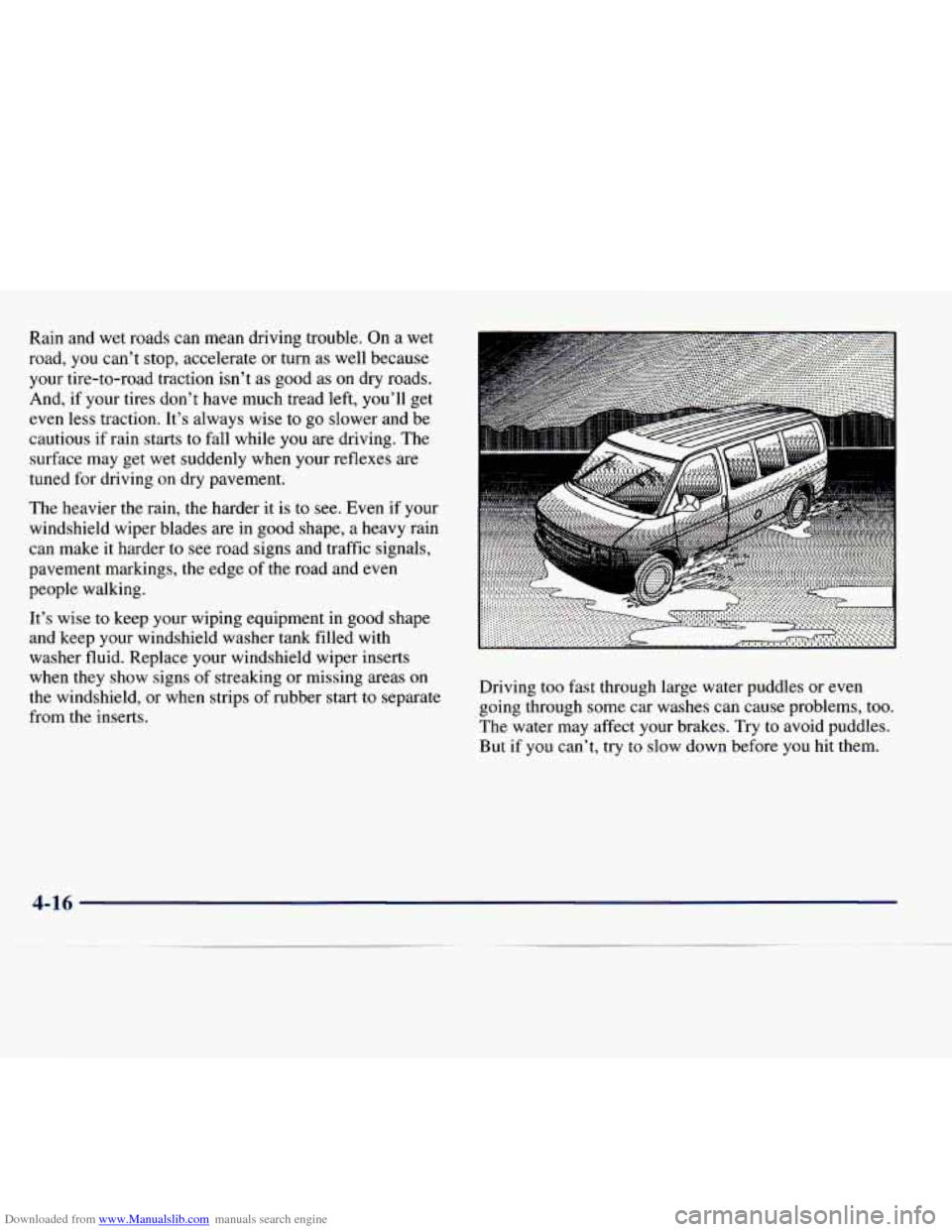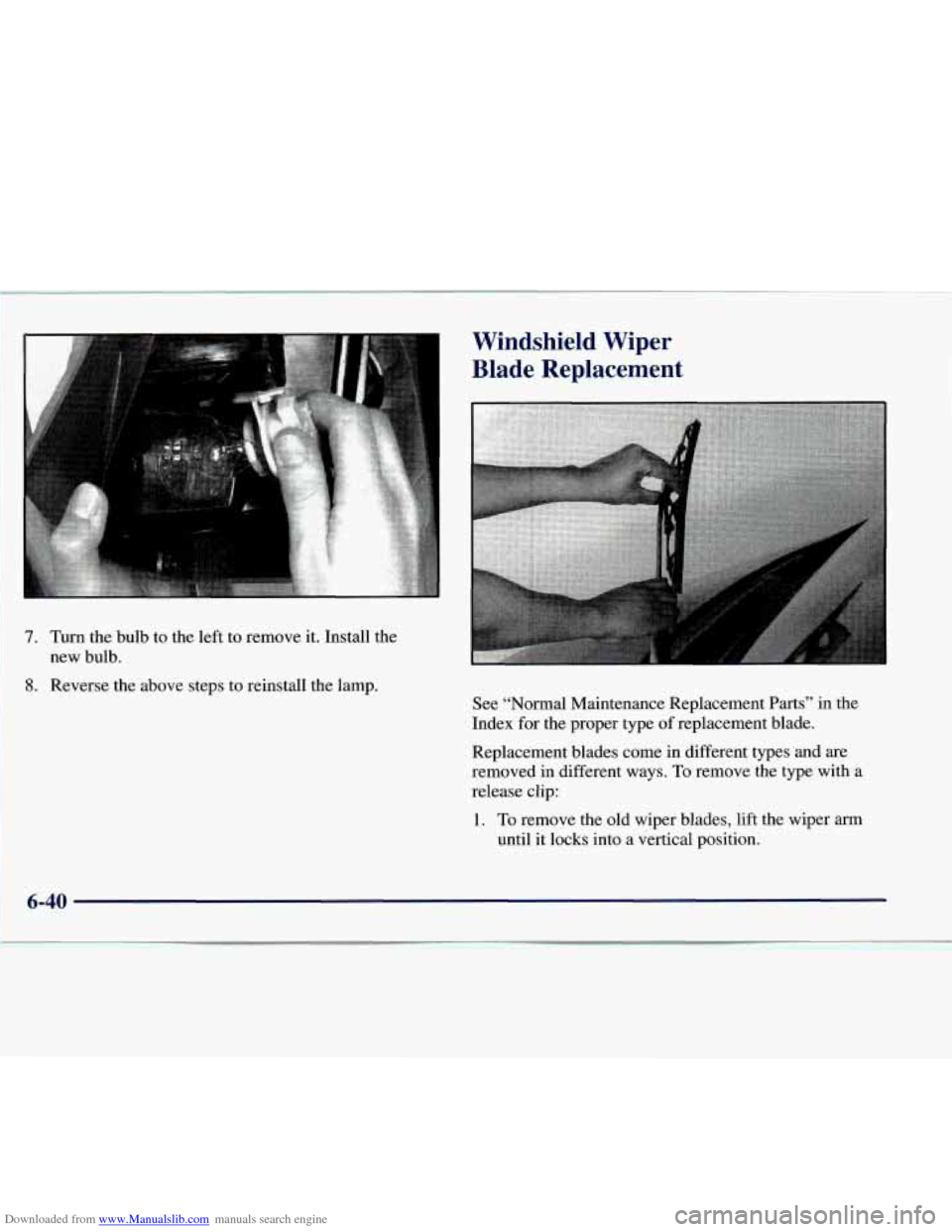1998 CHEVROLET EXPRESS wiper blades
[x] Cancel search: wiper bladesPage 107 of 386

Downloaded from www.Manualslib.com manuals search engine Windshield Wipers
You control the windshield
wipers
by turning the band
with the wiper symbol on it.
For a single wiping cycle, turn the band to MIST. Hold
it there until the wipers start, then let go. The wipers will
stop after one cycle. If you want more cycles, hold the
band on MIST longer.
You can set the wiper speed for a long or short delay
between wipes. This can be very useful in light rain or
snow, Turn the band to choose the delay time. The
closer
to LOW, the shorter the delay.
For steady wiping at low speed, turn the band to the
LOW position. For high-speed wiping, turn the band
further, to
HIGH. To stop the wipers, move the band
to OFF.
Remember that damaged wiper blades may prevent
you from seeing well enough to drive safely. To avoid
damage, be sure to clear ice and snow from the wiper
blades before using them. If they are frozen to the
windshield, carefully loosen
or thaw them. If your
blades do become damaged, get new blades or
blade inserts.
Heavy snow or ice
can overload your wipers. The
windshield wiper motor is protected from overload by a
circuit breaker and a fuse. If the motor overheats due to
heavy snow, etc., the wiper will stop until the motor cools.
Although the circuit is protected from electrical overload,
overload due
to heavy snow, etc. may cause wiper linkage
damage. Always clear ice and heavy snow from the windshield before using your windshield wipers.
2-36
Page 179 of 386

Downloaded from www.Manualslib.com manuals search engine Rain and wet roads can mean driving trouble. On a wet
road,
you can't stop, accelerate or turn as well because
your tire-to-road traction isn't as good as
on dry roads.
And, if your tires don't have much tread left, you'll get
even less traction. It's always wise to go slower and be
cautious if rain starts to fall while you are driving.
The
surface may get wet suddenly when your reflexes are
tuned for driving on dry pavement.
The heavier the rain,
the harder it is to see. Even if your
windshield wiper blades are in good shape, a heavy rain
can make it harder to see road signs and traffic signals,
pavement markings, the edge
of the road and even
people walking.
It's wise
to keep your wiping equipment in good shape
and keep your windshield washer tank filled with
washer fluid. Replace your windshield wiper inserts
when they show signs of streaking or missing
areas on
the windshield, or when strips of rubber start to separate
from the inserts. Driving too fast
through large water puddles or even
going through some car washes can cause problems, too.
The water may affect your brakes. Try
to avoid puddles.
But if
you can't, try to slow down before you hit them.
4-16
Page 183 of 386

Downloaded from www.Manualslib.com manuals search engine The exit speed is usually posted.
Reduce
your speed according to your speedometer, not
to your sense of motion. After driving for any distance
at higher speeds, you may tend to think you are going
slower than you actually are.
Before Leaving on a Long Trip
Make sure you’re ready. Try to be well rested. If you
must start when you’re not fresh
-- such as after a day’s
work
-- don’t plan to make too many miles that first part
of the journey. Wear comfortable clothing and shoes you
can easily drive in.
Is your vehicle ready for a long trip? If you keep it
serviced and maintained, it’s ready to
go. If it needs
service, have
it done before starting out. Of course,
you’ll find experienced and able service experts in
GM
dealerships all across North America. They’ll be ready
and willing to help
if you need it. Here
are some things
you can check before a trip:
0
0
Windshield Washer Fluid: Is the reservoir full? Are
all windows clean inside and outside?
Wiper Blades: Are they in good shape?
Fuel, Engine Oil, Other Fluids: Have you checked
all levels?
Lamps: Are they all working? Are the lenses clean?
Tires: They are vitally important to a safe,
trouble-free trip.
Is the tread good enough for
long-distance driving? Are the tires all inflated to the
recommended pressure?
Weather Forecasts: What’s the weather outlook
along your route? Should you delay your trip a
short
time to avoid a major storm system?
Maps: Do you have up-to-date maps?
4-20
Page 279 of 386

Downloaded from www.Manualslib.com manuals search engine Windshield Wiper
I Blade Replacement
7. Turn the bulb to the left to remove it. Install the
new bulb.
8. Reverse the above steps to reinstall the lamp.
See “Normal Maintenance Replacement
Parts” in the
Index for the proper type of replacement blade.
Replacement blades come in different types and
are
removed in different ways. To remove the type with a
release clip:
1.
To remove the old wiper blades, lift the wiper arm
until it locks into a vertical position.
6-40
Page 293 of 386

Downloaded from www.Manualslib.com manuals search engine Care of Safety Belts
Keep belts clean and d
I
Do not bleach or dye safety belts. If you do, it
may severely weaken them. In a crash, they
might not be able to provide adequate protection.
Clean safety belts only with mild soap and
lukewarm water.
Cleaning Glass Surfaces
Glass should be cleaned often. GM Glass Cleaner (GM
Part No. 1050427) or a liquid household glass cleaner
will remove normal tobacco smoke and dust films on
interior glass.
Don’t use abrasive cleaners on glass, because they
may cause scratches. Avoid placing decals on the inside
rear window, since
they may have to be scraped off later.
If abrasive cleaners are used on the inside
of the rear
window, an electric defogger element may be damaged.
Any temporary license should
not be attached across the
defogger grid.
Cleaning the Outside of the
Windshield and Wiper Blades
If the windshield is not clear after using the windshield
sap or other material may be on the blade
or windshield.
Clean the outside of the windshield with
GM Windshield
Cleaner, Bon
Ami@ Powder (non-scratching glass
cleaning powder),
GM Part No. 105OO11. The windshield
is clean if beads do
not form when you rinse it with water.
Grime from the windshield will stick
to the wiper blades
and affect their performance. Clean the blade by wiping
vigorously with a cloth soaked in full-strength windshield
washer solvent. Then rinse the blade with water.
I washer, or if the wiper blade chatters when running, wax,
Check the wiper blades and clean them
as necessary;
replace blades that look worn.
Weatherstrips
Silicone grease on weatherstrips will make them last
longer, seal better, and
not stick or squeak. Apply
silicone grease with a clean cloth at least every six
months. During very cold, damp weather more frequent
application may be required. (See “Recommended
Fluids and Lubricants’’
in the Index.)
Page 350 of 386

Downloaded from www.Manualslib.com manuals search engine . .- . ,east Twice a Year Automatic Transmission Check
Restraint System Check
Make sure the safety belt reminder light and all your
belts, buckles, latch plates, retractors and anchorages are
working properly. Look for any other loose or damaged
safety belt system parts. If you see anything that might
keep a safety belt system from doing its
job, have it
repaired. Have any torn or frayed safety belts replaced.
Also look for any opened or broken air bag coverings,
and have them repaired or replaced. (The air bag system
does
not need regular maintenance.)
Wiper Blade Check
Inspect wiper blades for wear or cracking. Replace blade
inserts that appear worn or damaged or that streak or
miss areas of the windshield. Also see “Wiper Blades,
Cleaning” in
the Index. Check the
transmission fluid level; add if needed. See
“Automatic Transmission” in the Index. A fluid
loss may indicate a problem. Check the system and
repair if needed.
At Least Once a Year
Key Lock Cylinders Service
Lubricate the key lock cylinders with the lubricant
specified in Part
D.
Body Lubrication Service
Lubricate all hood hinges, hood prop rod pivot, fuel
filler door, rear compartment hinges, latches, locks and
any moving seat hardware. Part
D tells you what to use.
More frequent lubrication may be required when
exposed to a corrosive environment.
Page 384 of 386

Downloaded from www.Manualslib.com manuals search engine Windshield Wiper .............................. 2-36 Wiper Blade Cleaning ........................... 6-54
Blade Replacement
........................... 6-40 Wiring. Headlamp .............................. 6-61
Cleaning the Blades
........................... 6-54 Wiper Blade Check ............................. 7-39
Fuses ...................................... 6-61 Wrecker Towing ................................. 5-8
Winter Driving ................................. 4-23 Wrench. Wheel ................................. 5-24
* 9-11